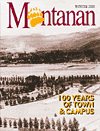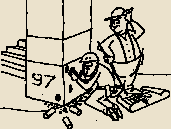
Winter 2000
CONTENTS
UM Researchers, Global Problems
In the Beginning
Of Politics, Presidents and Bulldozers
Books
AROUND THE OVAL
SPORTS
CLASS NOTES
ALUMNI NOTES
Contact Us
About the Montanan
PAST ISSUES
 Winter 2000 CONTENTS UM Researchers, Global Problems In the Beginning Of Politics, Presidents and Bulldozers Books AROUND THE OVAL SPORTS CLASS NOTES ALUMNI NOTES Contact Us About the Montanan PAST ISSUES |
by Harry Fritz 
The history of The University of Montana is all about politics, budgets, governance, consolidation and minimal legislative appropriations. Only one viewpoint is missing--the students! Through it all the University has been a fine place to get an education--and have some fun in the process. It still is. Here’s what’s happened. The University is the product of the biggest log-rolling, pork barrel session in the history of the Montana Legislature--and that’s saying something. Not until 1893 did Montana, a state since 1889, get around to locating its state institutions. Not even the site of the Capitol was fixed--Helena would win a raucous referendum the following year. The only given was the prison in Deer Lodge--it was impossible to move the walls. Deer Lodge citizens probably preferred a stable prison population to unpredictable college students anyway. Montana might have decided on a single, consolidated, central campus--the choice of academic and efficiency experts. Paris Gibson offered land and money in Great Falls. William A. Clark’s advisers wanted him to endow a major public university in Helena. But provincialism, regionalism and the desire for access proved too strong. In the end, Missoula got the university, Bozeman the land-grant agricultural college, Butte a school of mines, and Dillon a teachers’ college. Montana made a bad situation worse in the 1920s, when it added two more education schools, in Billings and Havre. Five vo-techs came later, as did state support for three private community colleges. Lately, we’ve tried to streamline the administration of these far-flung units. We still spread the education dollar thinly, however. But we do have access. It’s a lonely building, Main Hall, standing at the base of Mount Sentinel with nary a house in sight. The city of Missoula had barely crossed the Clark Fork River when the University moved to its present location in 1898. A diagonal path led to the south end of the Higgins Avenue Bridge. Trees, cows and Indian tepees broke the monotony. Isolation had one great benefit: There was plenty of parking. Apparently a time capsule was buried in the cornerstone of Main Hall when it was laid in 1897. But UM couldn’t locate it on the occasion of its Centennial celebration in 1993. We probed, poked, drilled, tapped and dug, but no capsule. What good is a time capsule if no one remembers where it is? Pictures from the early twentieth century look formal and staged. One shows serious science students standing next to some contraption. In another, the football team consists of undersized walk-ons. All classes were held in Main Hall at first, but soon a Science Building (demolished in the 1980s), a library (now Rankin Hall), and a Math Building (it’s still there) graced the Oval. 
University President E.B. Craighead waged a futile campaign for university consolidation in 1914. In good Progressive fashion, he certified a ballot initiative to locate one central unit in either Bozeman or Missoula. But the fix was in--Missoula supported the measure almost three to one, but Bozeman gave it less than eight percent of the vote. Only one problem: Which campus would move? Montana operated under a semester system until America entered the Great War in 1917. Then, to free up students for selective service more quickly, we switched to quarters. What will it take to bring back the quarter system, abolished by the state Board of Regents in 1991? Another world war? Another legacy of wartime is Student Health Services, established to help combat the influenza epidemic of 1918. The flu killed thirty million people worldwide, including about a half-million people in America--nearly five times as many as the war itself. My father, Nelson Fritz, enrolled at the University in 1924 and graduated five years later from the School of Forestry. He was a Phi Delt and a Yell King. But 1929 was not the best time to find a job in Montana. He left for twenty-five years. The University ran on fumes during the Depression. I knew a law professor who arrived here from Harvard in 1932 at a salary of $2,000 per year. Six years later he was still making $2,000 per year, although his family had doubled in size. If the legislature wouldn’t consolidate or abolish units when the state was flat broke, it never would. Ironically, enrollment crept up. Hard economic times are good for higher education--when there are no jobs, people go to school. The Second World War had a dual impact on the University. First, enrollment plummeted as young men went off to combat or to high-paying jobs in Pacific Coast defense industries. The gender ratio tilted dramatically in favor of women. But in 1944, equally dramatically, the trend abruptly reversed. The G.I. Bill, the most successful piece of social legislation in American history, poured hundreds of returning veterans onto campus. They lived with their families in makeshift housing along Maurice and South Avenues. UM enrollment doubled, to more than four thousand. These students were what we today call “nontraditional”--older, married with children, more serious, less party-oriented. They transformed higher education in Montana, and America. They created the modern university. 
By the 1950s, Missoula had caught up with UM. Residential areas now surrounded the campus and filled in the fields all the way to South Avenue, where my father had hiked cross-country to the golf course in the ’20s. The University was part of the city’s street system. A road ran around the Oval, connecting with Van Buren Street and the 600 block of University Avenue. Maurice Avenue was a pot-holed thoroughfare. Eddy, Keith and McLeod Avenues made inroads. The campus was divided, segmented. President Carl McFarland changed that. One night he ordered bulldozers and dump trucks to block all road entrances to the campus. Motorists cruising down Maurice suddenly faced a detour. One irate commuter sued. But he tangled with a former assistant attorney general of the United States, McFarland, who argued the University’s case and won, hands down. He created one of the most beautiful campuses in the country. No American college survived the ’60s unscathed. The Vietnam War and the Baby Boomers combined to double UM’s enrollment again. Protests, marches and strikes kept the local community on edge. Robert Pantzer earned his reputation as “the best president in the history of The University of Montana,” according to the Missoulian. He was “the UM leader who exercised the best judgment in dealing with and shaping a generation of students.” And what a generation! It included David Rorvik, the flamboyant Montana Kaimin editor, and Mark Racicot, now Republican governor of Montana. Hard times returned to the University in the 1980s. Economically, the decade was Montana’s worst since the Great Depression. State budget deficits and faculty salary freezes were the order of the day. Still, enrollment crept up--no jobs, remember?--but so, increasingly, did tuition. Today UM survives and even prospers in boom economic times. Maybe those times have not fully captured Montana, but somewhere there are jobs for college graduates. We still face budgetary problems, but when have we not? Costs and tuition escalate. But enrollment sets record highs almost every fall. President George Dennison is proud of his “Edifice Complex.” More construction and renovation have occurred during his tenure in the ’90s than at any time since the postwar building boom of the late ’40s and early ’50s. No one arriving on campus after 8:00 a.m. can find a parking place. Is anything new? Yes! Montana has had a winning football team ever since Don Read took over as coach in 1986. The Grizzlies won the I-AA National Championship in 1995, and they play in Washington-Grizzly Stadium, the largest public arena in Montana. Today we encourage diversity at the University, actively seeking American Indian and nontraditional students. We master the computer-generated communications revolution of our time. We prepare men and women to participate in the international, global economy. We’re doing something right.
Our troubles don’t faze our students. Despite the usual apocalyptic fare from the Kaimin, they soldier on. They know that with a little effort they can get an education as good as at any place in America. The faculty boasts world-class instructors in nearly every discipline. Classes are available, and most students don’t have to take eight o’clocks. I’ve never met anyone who regretted attending The University of Montana. Bring on the twenty-first century. Harry Fritz, a history professor at UM for a good part of the twentieth century, is often mistaken for Abraham Lincoln. Cartoons by Neil Wiegert of UM Printing and Graphic Services.
AROUND THE OVAL• SPORTS • CLASS NOTES • ALUMNI NOTES FEEDBACK•STAFF • ABOUT THE MONTANAN •ARCHIVES HOME • CONTENTS
|